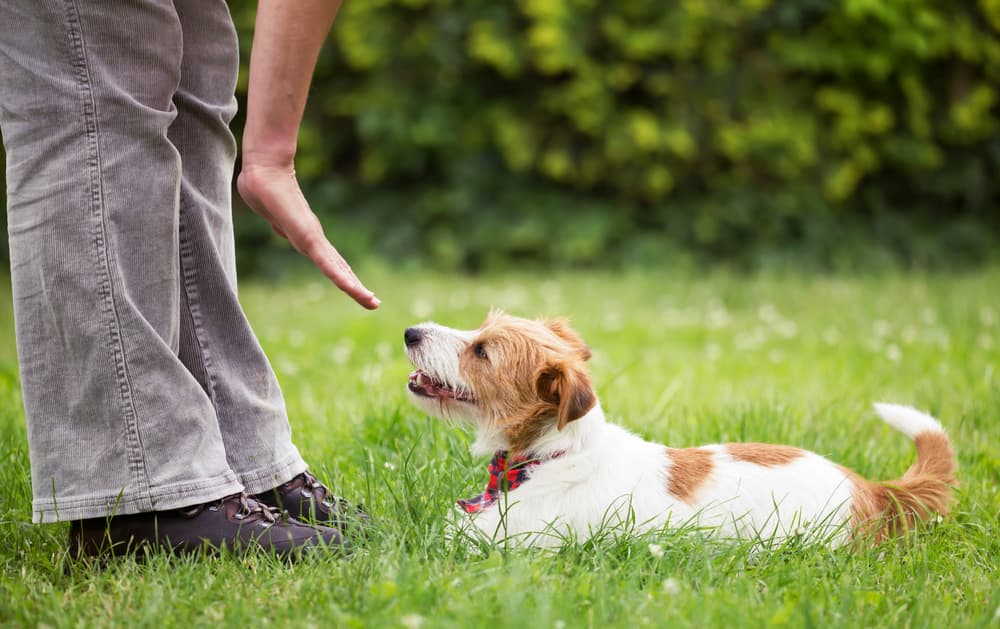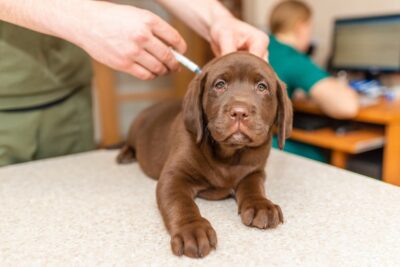15 Dangerous Mistakes That New Dog Parents Make

Becoming a new dog parent is a joyous event, but it’s also a huge responsibility that will impact you and your family for years to come. If you’re not experienced with dogs, it’s easy to unwittingly make beginner’s mistakes – and unfortunately, some mistakes can potentially harm your dog.
To help set you up for success, we’ve outlined some of the most common mistakes new pet parents make, coupled with suggestions for how to fix or prevent them.
Always check with your veterinarian if you have questions or are concerned about your dog’s health or behavior.
Not Developing an Early Relationship With a Veterinarian
Veterinarians play a pivotal role throughout a dog’s life, not just when problems arise. They perform wellness checks, detect diseases before they can worsen, and provide health recommendations based on your dog’s history. So waiting too long before setting up an appointment means your dog may be denied an optimal start.
Another plus to beginning a partnership with a veterinarian early on is that, “There is an established relationship in the future should illness or injury arise,” says Dr. Erin Katribe, medical director at Best Friends Animal Society in Kanab, Utah.
To help alleviate last-minute panic and set your dog up for a healthy life, find a veterinarian before bringing your new family member home.
Not Getting All Veterinarian-Recommended Vaccinations
Vaccinations help prevent diseases in dogs. “A lot of the diseases we vaccinate against we do not hear or see of them because we do vaccinate,” says Dr. Denise Pancari, a partner doctor with Heart + Paw in Centereach, New York.
Veterinarians usually recommend both core vaccines, as well as additional lifestyle-based vaccines (also referred to as noncore vaccines), says Dr. Katribe. Core vaccines include those for distemper, parvovirus, and rabies. Noncore vaccines – like those that protect against diseases like Bordetella, Lyme disease, and influenza – are recommended based on factors like your location and the dog’s risk of exposure to disease.
Additionally, “Puppies require a series of vaccinations to be considered fully protected, so be sure to follow the direction of a veterinarian regarding how many vaccines are recommended,” says Dr. Katribe.
Waiting Too Long Before Training Your Dog

Training is not just a tool used to address undesirable behavior. “Creating desired habits from the start is easier than retraining undesired behavior,” says Bradley Phifer, executive director of the Certification Council for Professional Dog Trainers.
Early training helps puppies acclimate to their new home and provides lifetime lessons, says Dr. Terri Bright, director of Behavior Services at MSPCA-Angell Animal Medical Center in Boston. “Pet parents should rely strictly on rewards-based methods and do their best to never frighten their puppy.”
Older and rescue dogs can benefit from training too, though pet parents can be lax at the beginning, says Phifer, who is a certified professional dog trainer. “They forgive what will end up being undesired behavior, like jumping up because the dog is new to the home. They assume the behavior will improve. Unfortunately, their inexperience or the hesitancy to train a recently rescued dog often allows for undesired behavior patterns to develop.”
Learning how to train a rescue dog or new puppy can prevent unwanted behaviors down the road. If you need additional guidance or the situation is unmanageable, reach out to your veterinarian or a certified dog trainer.
Not Properly Socializing Your Puppy
A puppy’s early weeks set the foundation for future behavior and relationships, says Dr. Bright. “Puppies who are isolated during this time are at risk of environmental fears and social deficits with other dogs and humans in the future, and there is no do-over to make up for the loss.”
Start socializing your dog at about the 8-week mark, recommends Dr. Bright, who is a board-certified behavior analyst and a certified applied animal behaviorist. She recommends getting them accustomed to being handled, as well as exposing them to known friendly dogs and environments they’re able to escape from if they become scared. “If they are frightened, they can have a little treat to attempt counter-conditioning, but escape will be important.”
Taking time to learn about the 7 steps to puppy socialization can help set your dog up for a lifetime of confidence. If you’re not having success, a certified dog trainer can be instrumental.
Not Understanding Environmental Risks
Potential dangers exist both outdoors and inside the home that can harm your dog’s health. Public places can be contaminated with potentially fatal diseases like parvovirus, says Dr. Katribe. “Regardless of vaccine status, puppies under 4 months of age may still be susceptible to contracting these diseases.”
Common household items can also be toxic or hazardous to dogs, says Dr. Katribe. “Especially for puppies, which are prone to chewing on almost anything they can get their mouths on. Even non-toxic things could pose a risk if ingested, like pieces of cloth or toys that can cause intestinal obstruction.”
Study up on household plants, backyard hazards, and toxins lurking in your environment that can potentially pose a danger to your dog. Dr. Katribe also recommends puppy- or dog-proofing your home until they learn to avoid potentially dangerous areas.
Setting Unrealistic Expectations

New dog parents often expect too much too soon from their dog, says Phifer. “Dogs need the opportunity to acclimate to a new home. Puppies need the opportunity to grow up and learn. Unfortunately, dogs often behave in unappealing ways until they adapt to a new home and receive appropriate training.”
Though dog trainers can help with the complexities of pet parenthood and training, there are also limitations, Phifer says. “They don’t have a magic wand to make a Border Collie not herd or a Rottweiler not be protective. We cannot train your 12-week-old puppy to hold its bladder during your entire workday or teach your German Shorthair Pointer to require less exercise.”
Researching the breed you intend to bring home can prevent some of this. If you’ve already committed to the adoption, try to realign your expectations and to accept your new dog for the good qualities she does possess.
Feeding an Inappropriate Diet
The food you choose for your dog is one of the most important decisions you can make for her health. Generally, veterinarians recommend a complete and balanced diet – which is one that contains essential nutrients in the correct amounts, as recommended by The Association of American Feed Control Officials (AAFCO).
Watch for diets that may not be nutritionally appropriate, recommends Dr. Pancari. For example, don’t attempt to cook a homemade diet for your dog without direction from your veterinarian or a veterinary nutritionist.
Your veterinarian can offer guidance on the best diet and proper caloric intake for your dog.
Not Providing Adequate Exercise
Along with a complete and balanced diet and appropriate caloric intake, exercise can help keep your dog fit. “Too little exercise can result in both health and behavior problems,” says Dr. Mary Burch, director of AKC Family Dog. Exercise can also help stave off obesity, which is linked to ailments like diabetes and arthritis.
Dr. Burch says most dogs need at least 30 minutes of exercise each day, though it can vary by individual and breed. “A common mistake related to exercise is the dog owner who doesn’t understand the exercise needs of a particular breed,” she says. A German Shepherd or Labrador Retriever will generally need more exercise than a Bulldog or Pug.
Ask your veterinarian for exercise recommendations — whether it’s walking, swimming, or agility training — and study up on your chosen breed’s physical requirements.
Not Developing Good Grooming Habits
Taking care of your dog’s skin and coat via regular bathing, brushing, and trimming of fur and nails is part of her health care routine. Grooming helps get rid of unwanted dirt and debris, can prevent infections, and allows you to find potential problems like flea infestations.
Attention to nails is important, too. “When we see a problem in the area at Canine Good Citizen tests, it is often that the dog’s nails have not been trimmed. If you hear click, click, click when the dog walks on a hard surface, the nails are too long,” says Dr. Burch, who is a certified applied animal behaviorist.
Grooming needs differ by dog breed. A long-haired breed like a Poodle or one that’s prone to matted hair will need more maintenance than a short-haired dog. Before adopting a dog, be certain you can commit to your breed’s grooming needs. Or locate a professional pet groomer in your area.
Not Being Prepared for Emergencies
Emergencies can arise, whether they’re in the form of broken teeth, bloat, or sudden vomiting. Knowing how to handle emergencies before they occur and budget for them can ultimately save your dog’s life.
It’s also helpful to identify an after-hours emergency veterinary clinic and have their number ready in the event of an after-hours emergency, recommends Dr. Katribe. “A general practice veterinarian can recommend local options for emergency care if they do not also provide after-hours services.”
Not Choosing to Spay or Neuter Your Dog
Sterilization not only prevents the birth of unplanned puppies, it also has health benefits, says Dr. Katribe. “Spaying female dogs completely eliminates the risk of potentially life-threatening uterine infections and can reduce the risk of mammary or reproductive cancers. For male dogs, neutering eliminates the risk of testicular cancer and can reduce the risk of prostate problems [1].”
A study from the University of Georgia also found that spaying and neutering your dog can increase their life expectancy. In fact, the study found that sterilization increased the lifespan of male dogs by 13.8 percent and females by 26.3 percent [2].
If your dog is not already spayed or neutered at the time of adoption, ask your veterinarian about the best time to have this procedure done.
Forgetting Proper Identification

Given that dogs who run away can become injured, traumatized, or permanently lost, fitting your pup with proper identification is critical. Veterinarians recommend both microchipping and external identification to prevent unnecessary tragedies.
“Collars and tags can become lost, so a permanent microchip that is registered with contact information kept current (the registration and current information is crucial!) can help dogs make it back home once they are scanned at a shelter or clinic,” Dr. Katribe says. Conversely, “Because most people that might find the dog don’t have scanners, though, a microchip shouldn’t replace a low-tech collar and identification tag,” she adds.
Not Adequately Researching the Breed
Though you may have your heart set on a particular breed, it may not be the best fit. “Proper breed research can help an owner with identifying what type of exercise or environment engagement the new puppy or dog may need. This will also help with common genetic disease or abnormalities that can be breed specific,” says Dr. Pancari.
Study everything about the breed you’d like to bring home, including energy level, potential health risks, dietary and grooming needs. If you still have questions, a certified professional dog trainer can help, says Phifer. “They know how to help you to select a dog whose personality and breed type complement yours.”
Not Practicing Good Etiquette
Part of being a good dog parent involves practicing good manners when outside of the home. This includes not letting your dog run loose in the neighborhood or to become a nuisance barker, says Dr. Burch. Additionally, “Not picking up the dog’s waste in public and wilderness areas is a big mistake that can result in dogs no longer being welcome at a hotel or on a hiking trail,” she says.
Through the AKC’s Responsible Dog Owner’s Pledge, Dr. Burch says dog parents agree to properly confine the dog (whether with fences or leashes), provide proper identification, keep dogs safe if they get loose, and provide adequate supervision when dogs and children are together.
Failing to Get Pet Health Insurance
An unforeseen illness or accident can result in thousands of dollars in unexpected veterinary bills. Pet health insurance allows you to provide optimal veterinary care without having to tap into your savings. “The best time to get insurance is as early as possible, prior to any known congenital disorders or puppy accidents occurring,” says Dr. Pancari
If pet insurance is too costly right now, Dr. Pancari recommends creating a pet savings account that you contribute a small amount to each month.
You may also want to consider purchasing a pet wellness plan, which helps cover the costs of preventative care, including microchipping, vaccinations, and wellness exams.









